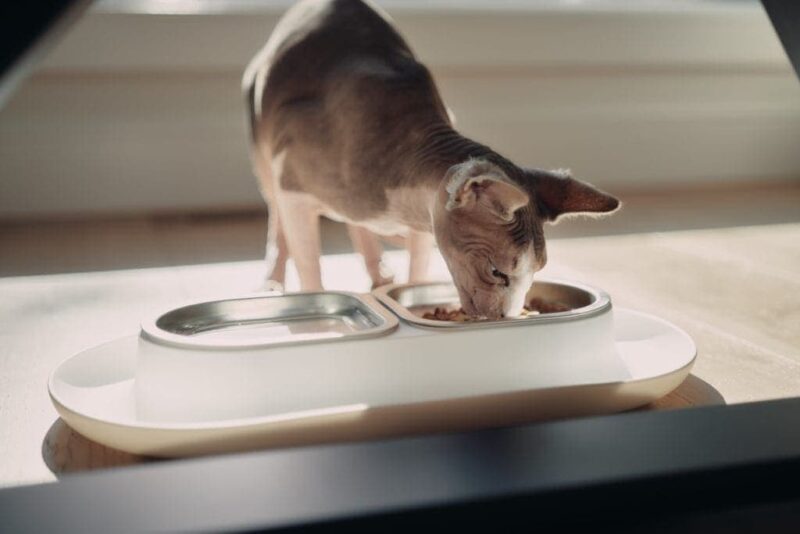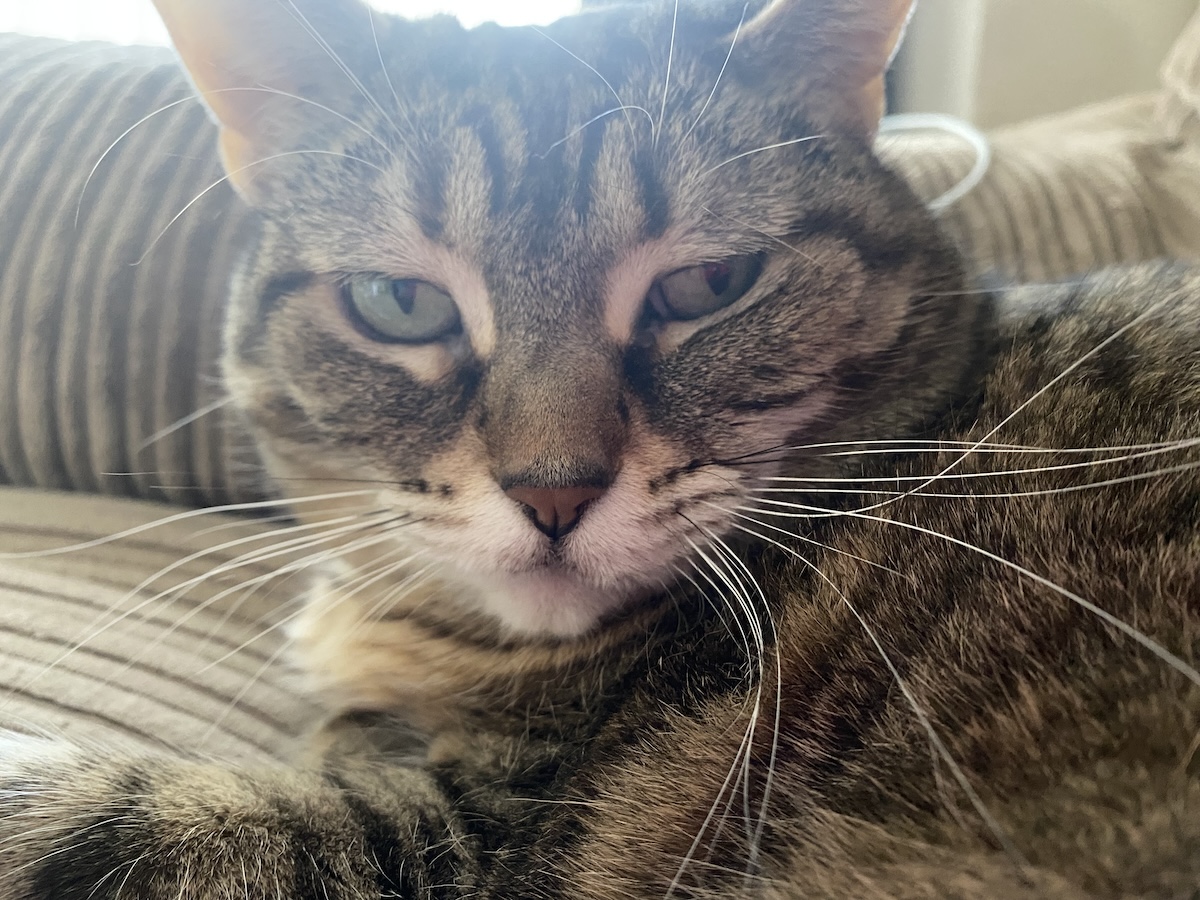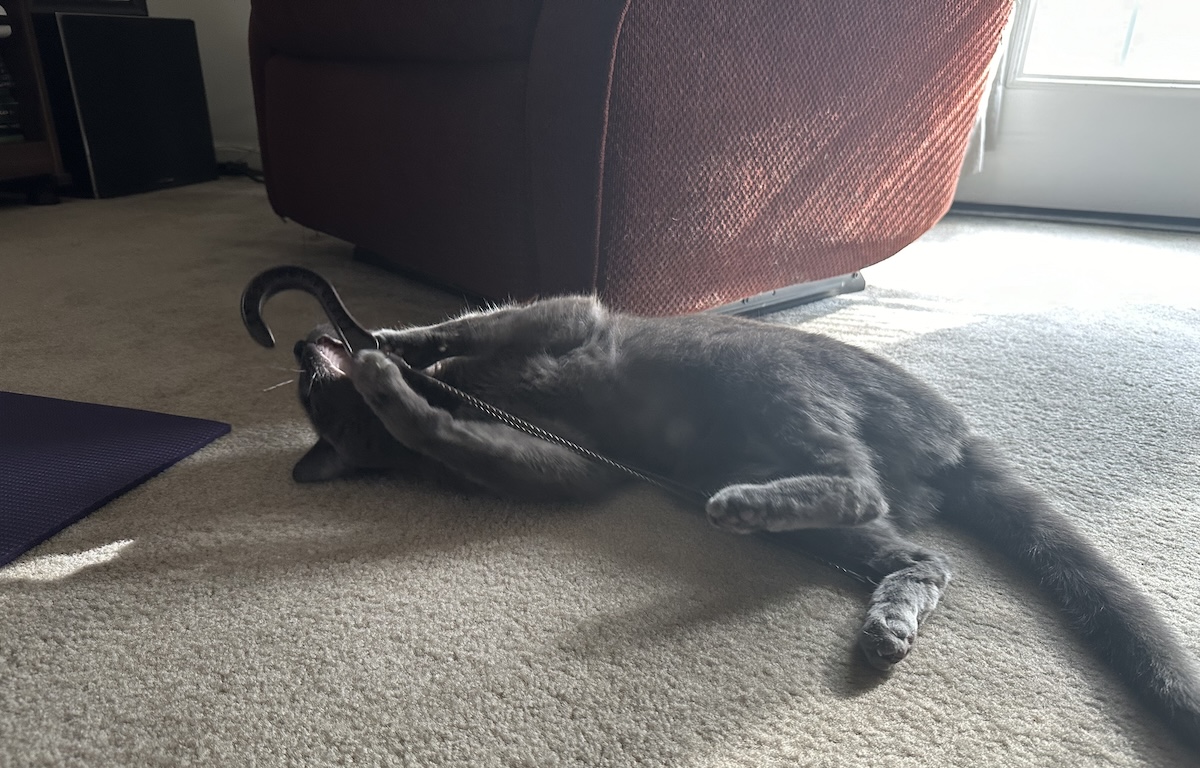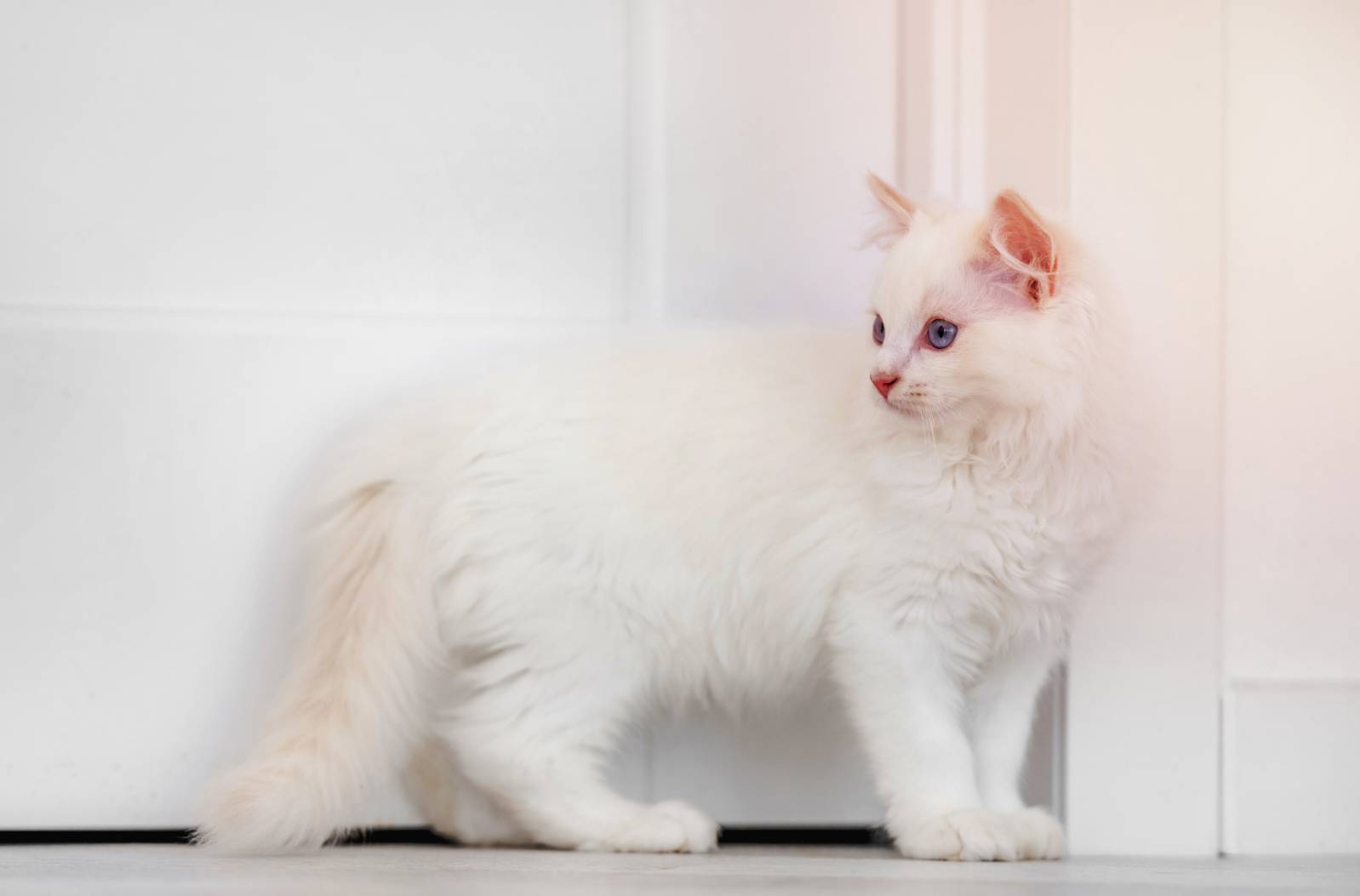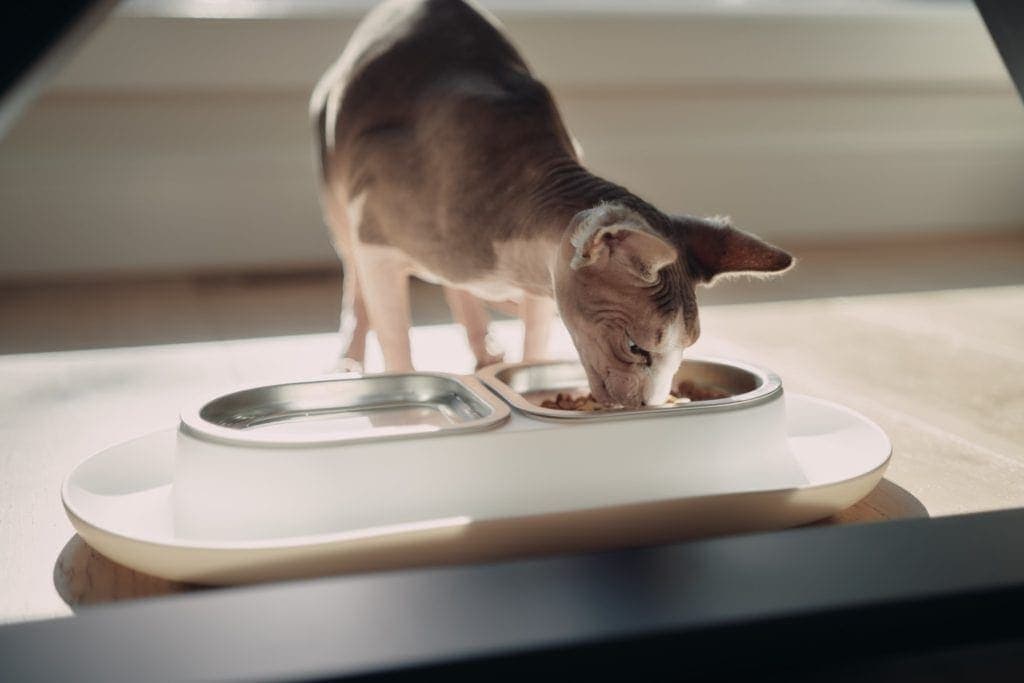
We’re here to help! We created reviews of the best cat bowls in Canada this year. Hopefully, you’ll find the right one for your cat.
A Quick Comparison of Our 2024 Winners
| Image | Product | Details | ||
|---|---|---|---|---|
| Best Overall |
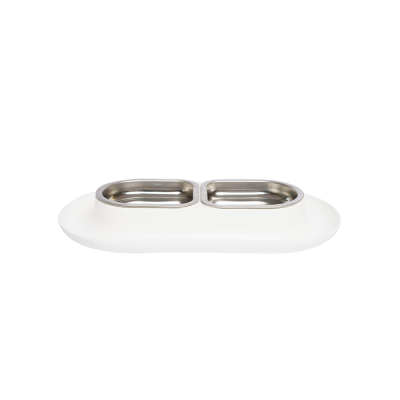
|
Hepper Nom Nom Bowl |
|
CHECK PRICE |
| Budget Buy |
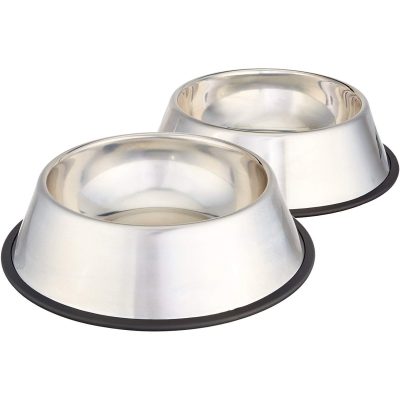
|
AmazonBasics Stainless Steel Food Bowls |
|
CHECK PRICE |
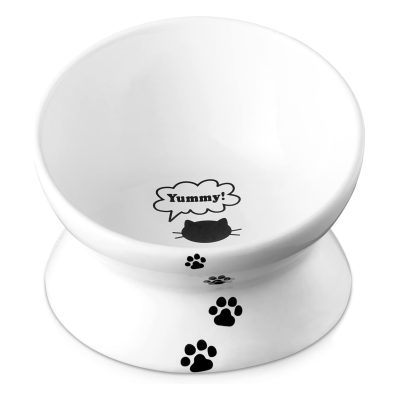
|
Y YHY Raised Cat Bowl |
|
CHECK PRICE | |
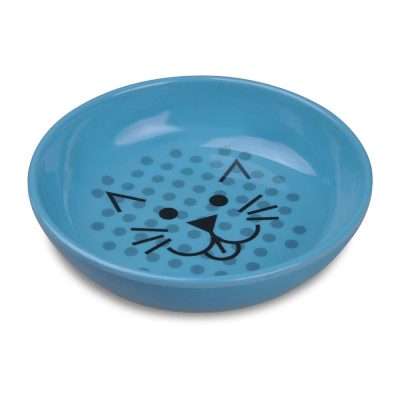
|
Van Ness Ecoware Cat Dish |
|
CHECK PRICE | |
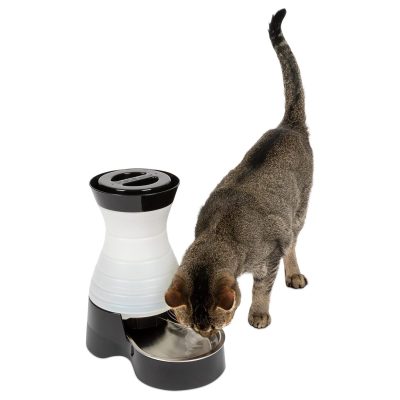
|
PetSafe Healthy Pet Water Station |
|
CHECK PRICE |
The 8 Best Cat Bowls in Canada
1. Hepper Nom Nom Cat Bowls — Best Overall
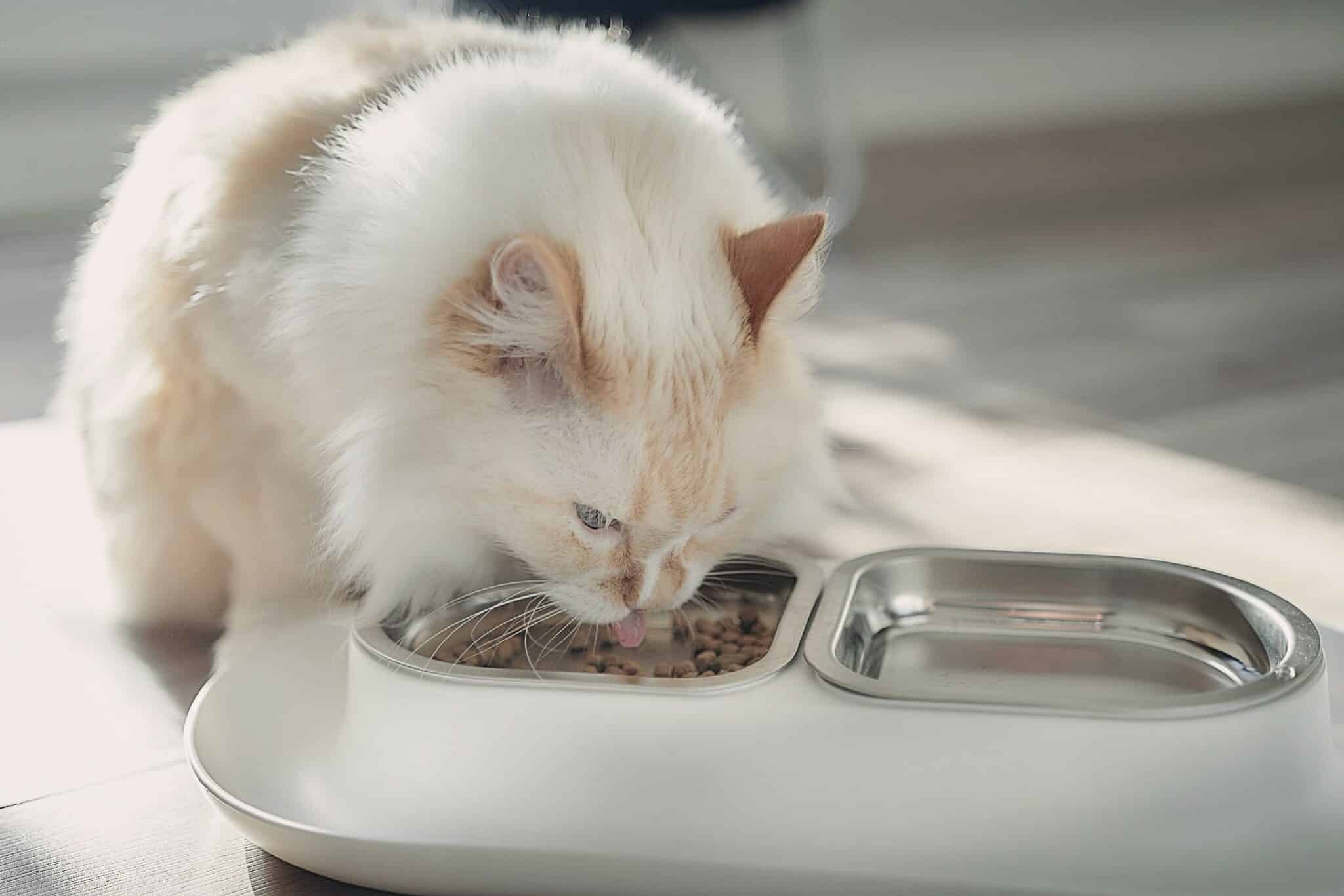
| Materials | Stainless steel, plastic |
| Colours | White, green |
| Size | 9 x 16 x 2 inches |
The best overall cat bowl in Canada is the Hepper Nom Nom Bowl. It’s whisker friendly, durable, and dishwasher safe. This product includes two shallow stainless-steel bowls that help prevent whisker fatigue and are contained within a sturdy plastic base with a wide tray. This tray can help catch your cat’s mess while eating, or if ants are an issue, you can keep water in it as a little mini moat. The entire set is dishwasher safe, sturdy, and easy to keep clean.
It is more expensive than a few other options on this list, but the design, durability, and comfort that it provides to your cat while they eat are well worth the investment.
At Catster, we’ve admired Hepper for many years and decided to take a controlling ownership interest so we could benefit from the outstanding designs of this cool cat company!
- Available in two colours
- Shallow bowls are great at preventing whisker fatigue
- Dishwasher safe
- Wide rim can catch mess or with water, create a moat against ants
- Expensive
2. AmazonBasics Stainless Steel Cat Food Bowls — Budget Buy
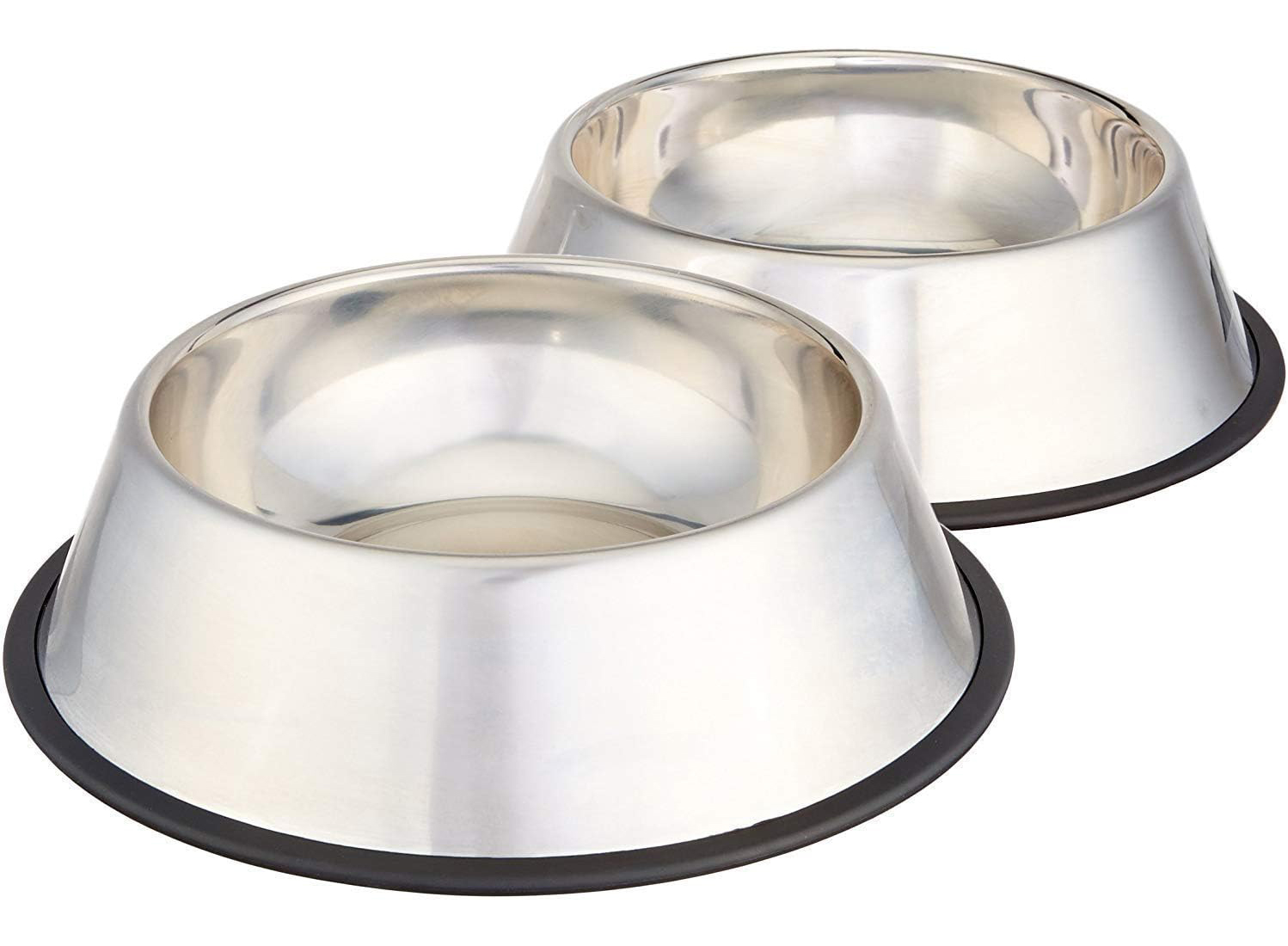
| Materials | Stainless steel, rubber |
| Colours | Silver |
| Size | 10 x 10 x 2.8 inches |
The AmazonBasics Stainless Steel Food Bowls set is the best cat bowl in Canada for the money, and it’s untippable! You get two bowls that are dishwasher safe, hold 4.75 cups of food each, and are rimmed with rubber along the base to prevent them from slipping, which additionally prevents damage to your floors. The wide base can also stop them from being tipped over.
The disadvantages of these bowls are that they might eventually lose the rubber rim, and they might be too big for some cats.
- Great price
- Two bowls in stainless steel
- Each holds 4.75 cups of food
- Bases are rimmed with rubber to prevent slippage
- Wide base prevents tipping
- Dishwasher safe
- Rubber rim might fall off
- Bowls might be too large for some cats
3. Y YHY Raised Cat Bowl
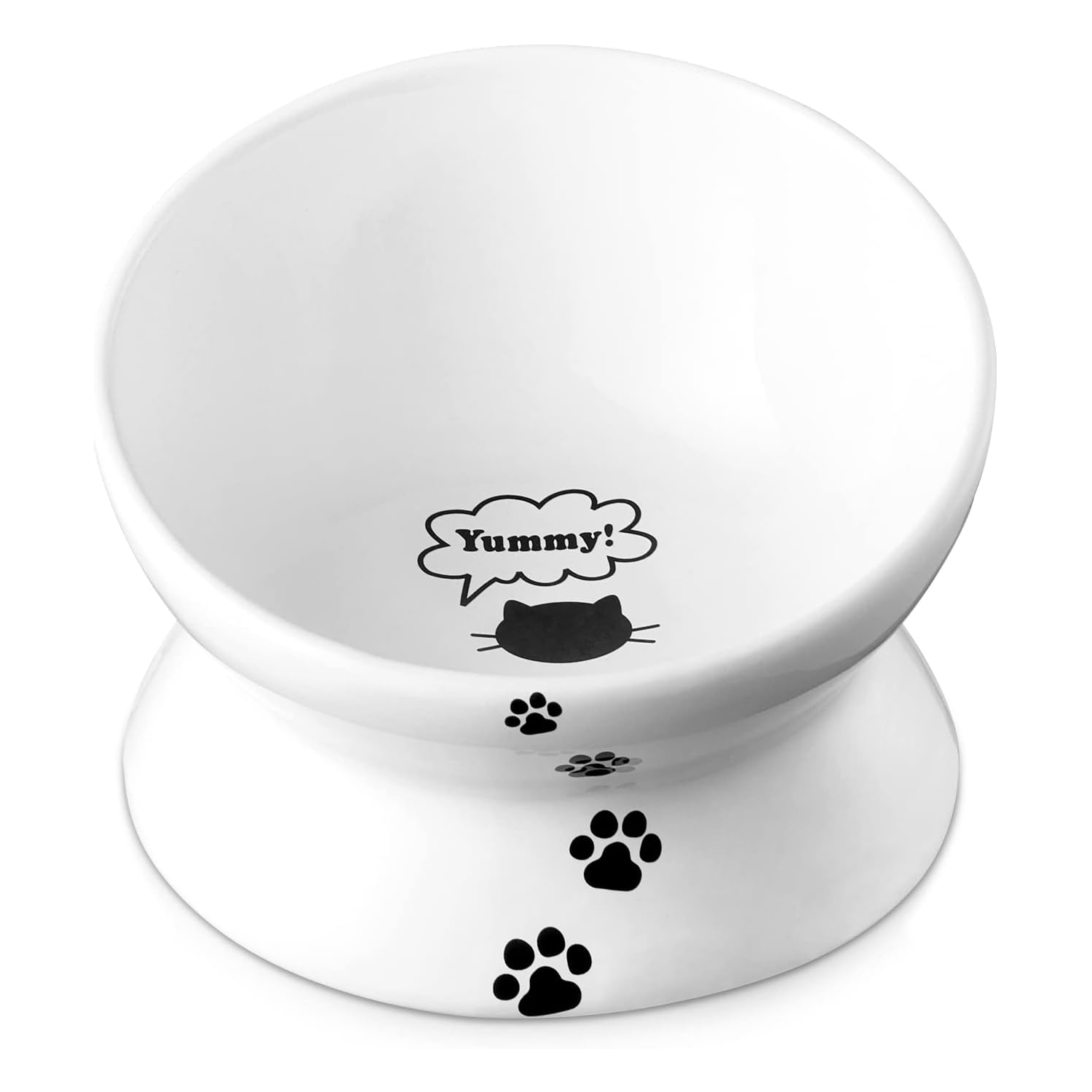
| Materials | Ceramic |
| Colours | White, grey, blue |
| Size | 5 x 5 x 3,6 inches |
Another great option is the Y YHY Raised Cat Bowl for its easy access. It has an elevated base and is tilted forward so cats can access their food easily, which will help flat-faced and senior cats, as well as cats prone to vomiting. The tilted position also puts less strain on the cat’s neck. It’s made of ceramic and comes in three colours, with super cute little black pawprints on the front. It’s dishwasher safe, and the wide base makes it hard to tip over.
One of the negatives is that it is quite expensive, particularly since it’s just one bowl. Additionally, some models might be prone to chipping.
- Elevated and easy access
- Helps cats prone to vomiting, as well as flat-faced and senior cats
- Made with ceramic
- Dishwasher safe
- Comes in three colours, with a cute paw print design on the front
- Wide base makes it almost impossible to tip over
- Expensive
- Prone to chipping
4. Van Ness Ecoware Cat Dish
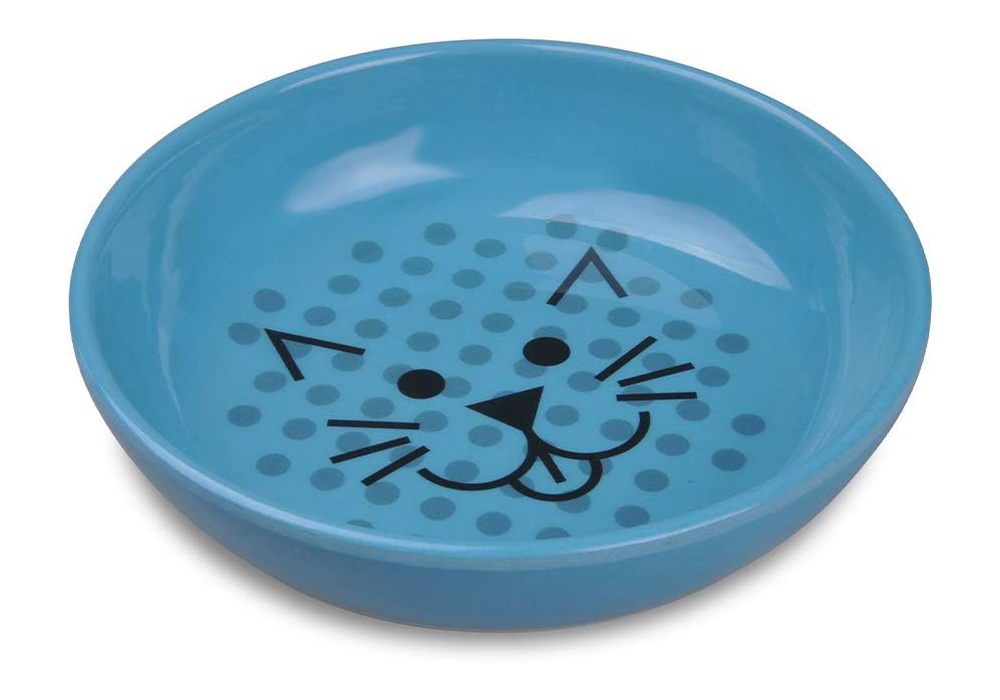
| Materials | Silicone and bamboo |
| Colours | Blue |
| Size | 2 x 5.2 x 1.2 inches |
The Van Ness Ecoware Cat Dish is great for kittens because it’s shallow and flat and has an excellent price. This design will also help prevent whisker fatigue. It’s made from a plastic resin that’s made from plant material that includes bamboo. It has a silicone base to prevent slipping and is dishwasher safe. These bowls are environmentally friendly and durable.
Unfortunately, they can only be hand washed or they will get damaged. Also, if your cat is a messy eater, these bowls might not be suitable because they are so shallow.
- Good price
- Low and flat: good for kittens and prevents whisker fatigue
- Plastic resin made with plant material, with a silicone base to prevent slipping
- Environmentally friendly and unbreakable
- Hand-wash only
- May not be suitable for messy eaters
5. PetSafe Healthy Pet Water Station
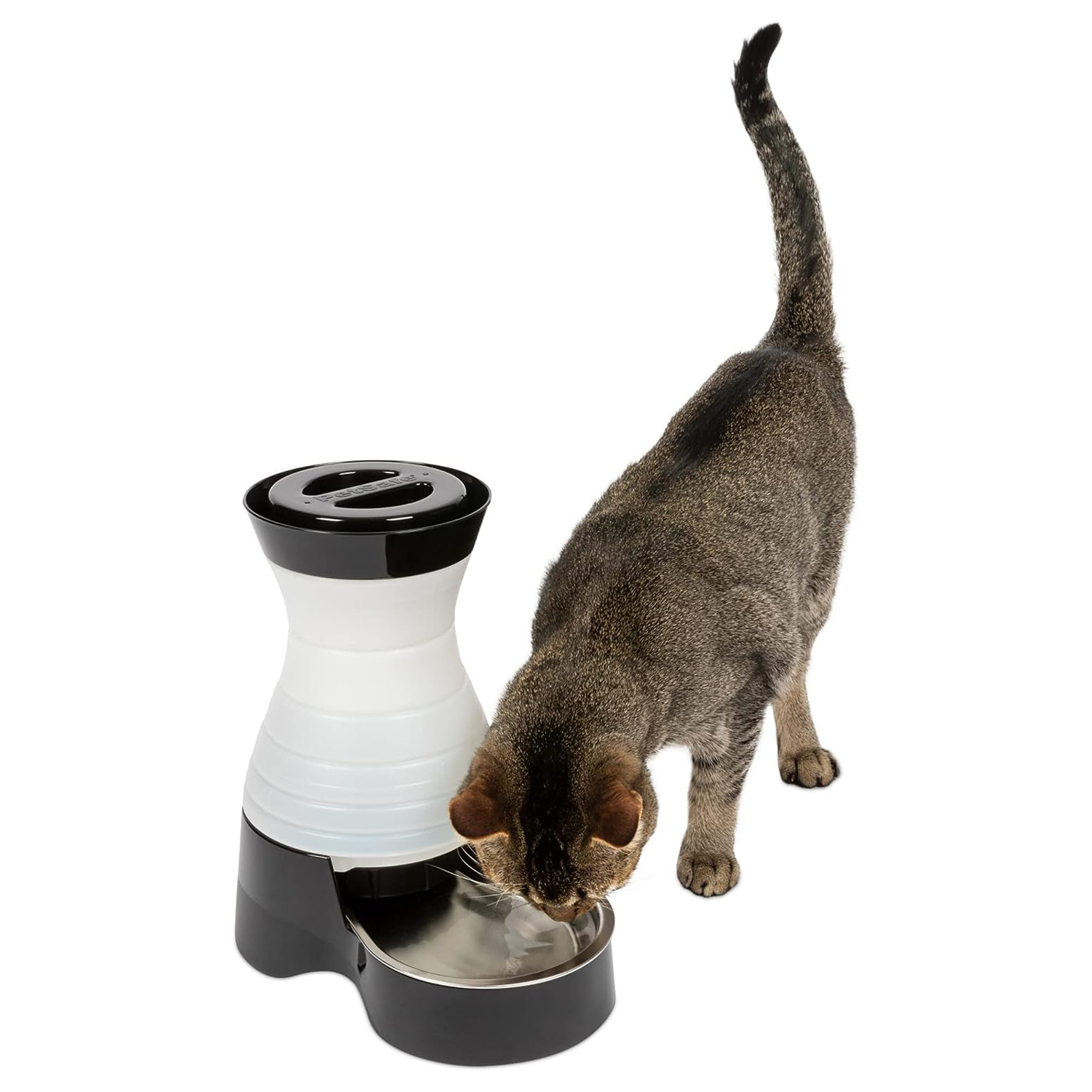
| Materials | Stainless steel, plastic |
| Colours | Silver, black, and white |
| Size | 4-inch diameter, 2.25-inch depth |
PetSafe’s Healthy Pet Water Station holds about 8 cups of water and uses gravity to keep your cat’s bowl full. The bowl is stainless steel and dishwasher safe, and the reservoir is made with BPA-free plastic, which locks in place so it can’t be knocked over. It also comes in medium and large.
However, the gravity system doesn’t always work, and if any part breaks, there are no replacements, so you’d have to buy the entire station again.
- Holds 8 cups, so your cat has constant access to water
- Stainless-steel bowl is dishwasher safe
- Reservoir made with BPA-free plastic locks on to prevent spilling
- Also available in medium and large
- Gravity system might not work
- If any part breaks, there are no replacements
6. Kitty City Cat Bowls
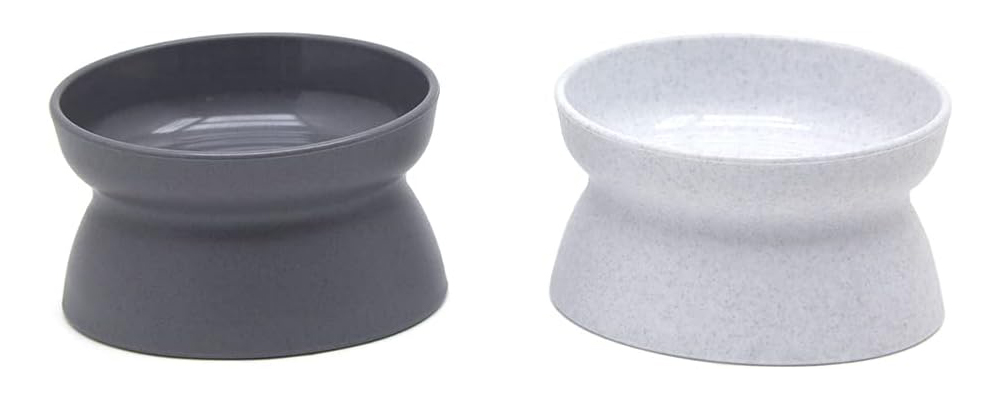
| Materials | Plastic |
| Colours | Grey, white |
| Size | 38 x 3.25 x 4 inches |
The Kitty City Cat Bowls has two separate plastic (safe for pets) bowls, with one in white and one in grey. Each bowl holds a little less than 1 cup and has a base that acts as a pedestal, which elevates them to a higher level, making eating easier for your cat. The bowls are slightly tilted, are wide enough to limit whisker fatigue, and are dishwasher safe.
On the downside, these bowls are a little small and quite lightweight, so they can be tipped over and might be prone to travelling around the floors while your cat eats.
- Two bowls elevated to a higher level
- Bowls are slightly tilted and wide to prevent whisker fatigue
- Made with pet-safe plastic
- Dishwasher safe
- Bowls are small
- Light and tend to travel across floor
7. DotPet Slow Feeder Cat Bowl
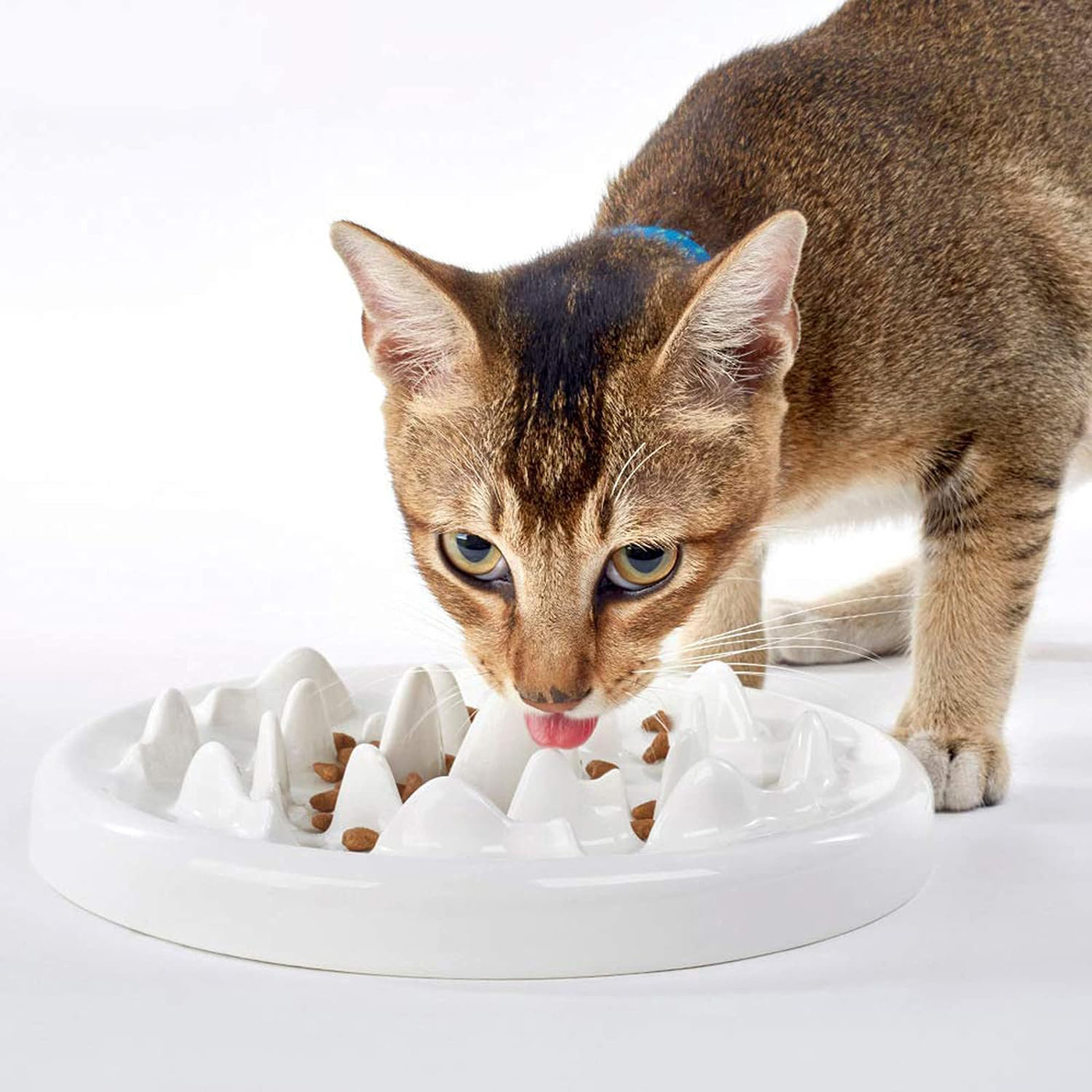
| Materials | Ceramic |
| Colours | White |
| Size | 7 inches diameter and 1.6” height |
DotPet’s Slow Feeder Bowl is a great option if you have a cat that tends to overeat or eats too fast. It contains valleys and ridges that your cat needs to eat around, which can slow down the eating and increase mental stimulation. This design can help prevent obesity and stomach upset due to indigestion. It’s ceramic, so it’s a safe material for both the microwave and dishwasher. It’s also heavy enough that it can’t be easily pushed around by your cat.
On the negative side, it might not work that well for large cats because they might have too much trouble getting to the food. Also, determined cats might make a mess by pushing the food out of the bowl and onto the floor.
- Bowl designed to slow down eating
- Helps prevent obesity, bloat, and indigestion
- Ceramic, so dishwasher and microwave safe
- Ridges and valleys slow down eating and increase mental stimulation
- Heavy enough to avoid travelling
- Large cats might not be able to get at the food
- Some cats might push the food onto the floor

| Materials | Ceramic and metal |
| Colours | White and black |
| Size | 4 x 5.5 x 3.2 inches (bowls have 5.1” diameter) |
The Navaris Ceramic Pet Bowl Set contains three ceramic bowls in an attractive black metal stand, but you also have the option of a slightly cheaper version with only two bowls. The frame helps slightly elevate the bowls and has anti-slip silicone on the legs. The white bowls have cute black pawprints on the bottoms and are removable and dishwasher safe.
Unfortunately, these bowls are expensive and prone to chipping, so handle them with care. Additionally, if your cat wears a collar with a bell or other dangling object, it might get caught in the metal stand.
- Three ceramic bowls on an attractive metal stand
- Stand elevates the bowls and has anti-slip silicone on the legs
- Bowls are removable and dishwasher safe
- Expensive
- Bowls prone to chipping
- Cats might get collars stuck in the stand
Buyer’s Guide: Choosing the Best Cat Bowl in Canada
Before you make your final decision, check out this buyer’s guide. We go over important factors that could impact your final choice of cat bowls.
Whisker Stress
Whisker fatigue, also called whisker stress, is something that can occur when your cat eats from narrow and deep bowls. A cat’s whiskers are surrounded by blood vessels and sensitive nerve endings, making them very sensitive in general. When a cat eats from a narrow bowl, this will cause their whiskers to press up against the bowl, which can be quite uncomfortable.
If you notice your cat flipping food out of their bowl and eating it off the floor, it could be a funny quirk, but it’s typically a sign of whisker fatigue. As a general rule, it’s usually safest to opt for wide and shallow bowls.
Size and Shape
Wide and shallow bowls are usually recommended by experts. This not only helps avoid whisker fatigue, but when a cat eats from a deep bowl, it can also cause extra stress for a different reason. If a bowl is deep enough, cats won’t be able to see what’s going on in their vicinity and may be reluctant to eat. This is another reason that shallow bowls are best.
Elevated
Certain breeds of cats generally do better with elevated and tilted bowls, such as Persians or cats with specific health issues. It is more of a challenge to eat from a deep bowl while crouched down. Many cats will do better with elevated and tilted bowls, particularly if they have stomach or gastrointestinal issues.
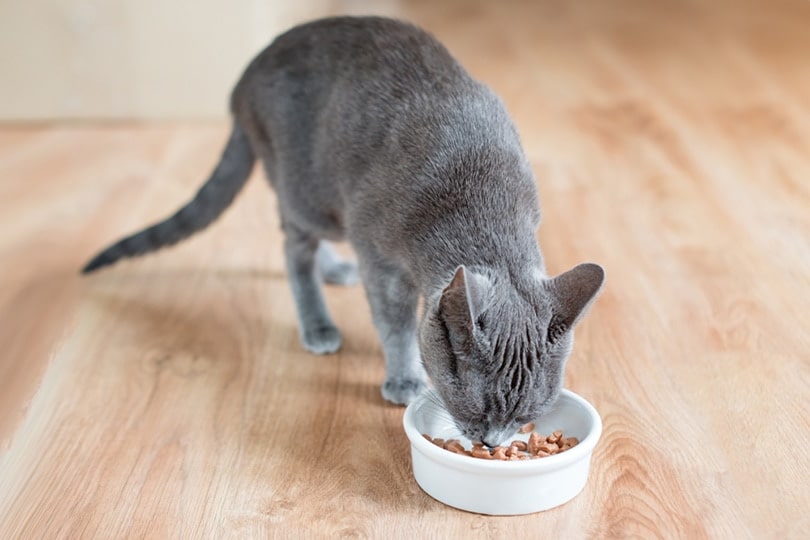
Material
Plastic bowls aren’t good for all cats. This material tends to become scratched rather easily, which can contribute to trapped bacteria. You’ll need to clean the bowls more frequently (which can lead to more scratching), and some cats are even prone to cat acne when eating from plastic bowls. Ceramic and stainless-steel bowls tend to be more sanitary and easier to clean.
Non-slip
Some cats love to eat with a great deal of enthusiasm, which can lead to a bowl that moves all over the kitchen. This can put off the cats from eating. It can also lead to the bowl being frequently tipped over, so you’ll want to aim for a bowl (or stand) that has some kind of non-slip rubber or silicone grips. Other bowls can be heavy enough that they won’t travel, such as one made with high-quality ceramic.
Separate Water Bowl
As a general rule, most cats prefer their food to be separate from their water source, as the water can become easily contaminated when next to food. Many cats also prefer running water, so investing in a cat water fountain will not only make your cat happy but can also contribute to a longer life for them.
Cats are prone to kidney disease, so increasing the amount of water that they drink at a young age can help prevent such health conditions. You will probably notice your cat drinking more water when you switch to a cat water fountain.
Final Verdict
In summary, the Hepper Nom Nom Bowl is our choice for the best overall cat bowl because it’s whisker friendly, durable, and dishwasher safe. The AmazonBasics Stainless Steel Food Bowls won’t slide across the floor and have a great price. Lastly, the Y YHY Raised Cat Bowl is pricey, but it’s a safe and solid bowl made with ceramic and is cute too!
Now that you’re armed with all this information, we hope that these reviews have helped you find the perfect bowl for your very important family member!
- See Also: Best Cat Harnesses in Canada
Featured Image Credit: Hepper
Contents
- A Quick Comparison of Our 2024 Winners
- The 8 Best Cat Bowls in Canada
- 1. Hepper Nom Nom Cat Bowls — Best Overall
- 2. AmazonBasics Stainless Steel Cat Food Bowls — Budget Buy
- 3. Y YHY Raised Cat Bowl
- 4. Van Ness Ecoware Cat Dish
- 5. PetSafe Healthy Pet Water Station
- 6. Kitty City Cat Bowls
- 7. DotPet Slow Feeder Cat Bowl
- 8. Navaris Ceramic Pet Bowl Set
- Buyer’s Guide: Choosing the Best Cat Bowl in Canada
- Final Verdict


